Samsung Galaxy S 4 Review - Part 1
by Brian Klug on April 24, 2013 12:01 AM ESTBattery Life and Charge Time
The Galaxy S 4 features a removable 9.88Wh battery with 3.8V chemistry. The battery design is par for the course for any high end smartphone, but the fact that it's removable remains a staple of the Galaxy S design. Whether or not the bulk of consumers actually use the flexiblity offered by a removable battery is up for debate, but there's no doubt about the fact that Samsung has a strong following of users who appreciate the feature.
Unfortunately, only having access to the Sprint version of the Galaxy S 4 to review, most of our battery life tests on the cellular network aren't all that useful. The good news is that our WiFi tests should at least give you an idea of how well the SGS4 will compare to the HTC One when both are on the same network. We're using the latest revision of our smartphone battery life test to compare performance of all the key players here. This is now our sixth revision of the battery life test, and we feel is the optimal balance between challenging workloads and idle time. The basic overview is the same as the previous test — we load webpages at a fixed interval until the handset dies, with display set at exactly 200 nits as always. Power saving features are disabled if they turn on automatically, and background account sync is disabled. The test is performed over both cellular data on all available air interfaces and over WiFi in an environment with good signal levels. The new test has decreased pause time between web page loads and added a number of JavaScript-heavy pages. I sat down with some UMTS RRC (Radio Resource Control) emulator tools and also made sure we had a good balance of all the RRC states (DCH, PCH if possible, FACH, IDLE) so we weren’t heavily biased towards one mode or the other.
As the most relevant comparison of platforms we have today, we'll start with the WiFi version of our web browsing test:
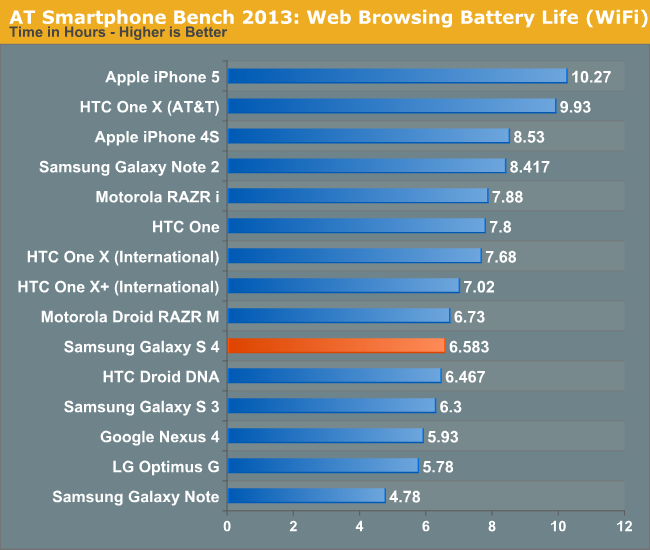
On WiFi the Galaxy S 4 falls behind the HTC One by an appreciable amount, however there's still an improvement in battery life compared to the Galaxy S 3. The Galaxy S 4's battery life isn't bad by any means, but do keep in mind that this is a large phone with a large display and a very powerful SoC. For much of the past year we've been talking about an increase in dynamic range in total platform power of high end smartphones and the Galaxy S 4 is no exception. Run it at full brightness or keep many cores running in their maximum performance states for a considerable period of time and you'll be greeted by a phone that's quickly in need of a power outlet.
As I mentioned earlier, we only have access to the Sprint version of the Galaxy S 4 at this point which unfortunately means that our 3G results aren't all that comparable to other devices here.

Even on Sprint, the Galaxy S 4 does surprisingly well.
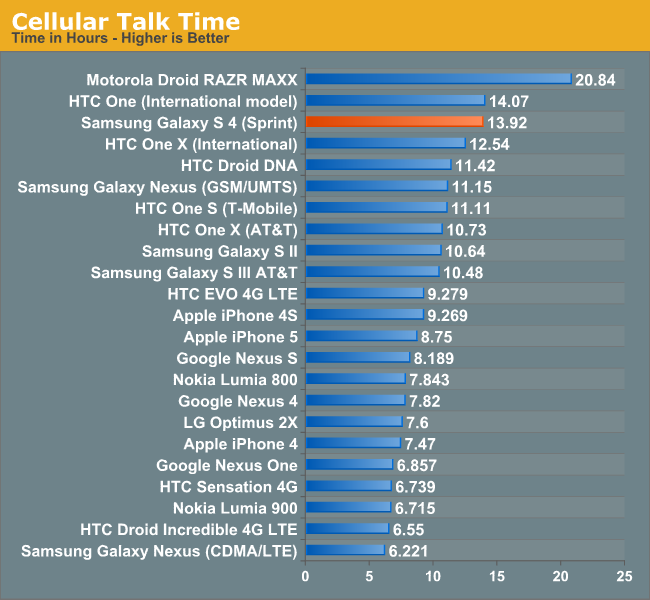
Talk time is excellent on the Galaxy S 4, with the phone delivering effectively the same battery life as the HTC One. Without having to power on that huge display, the Galaxy S 4 can last for a very long time on a single charge.
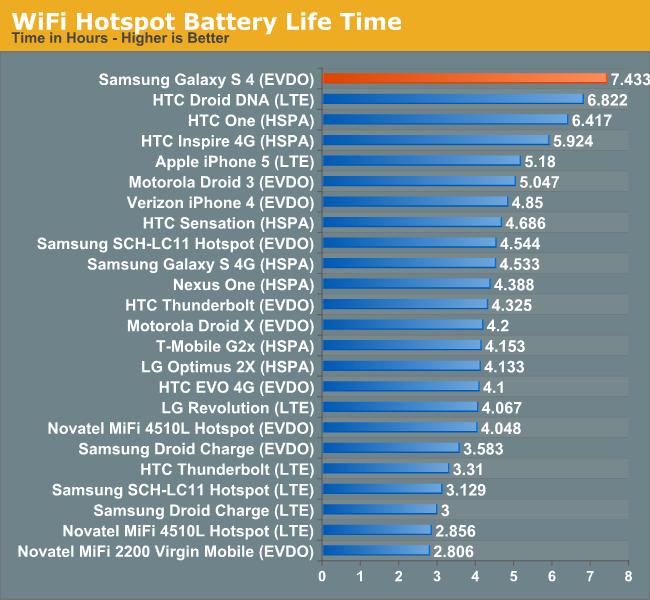
A combination of the Sprint network and the fact that the Galaxy S 4's display remains off during our hotspot test resulted in great battery life here as well. Again, this data isn't all that useful if you're not on Sprint but Samsung tells us we should be able to get our hands on an AT&T SGS4 in the not too distant future.
Charge Time
Samsung appears to implement Qualcomm's Quick Charge specification in the Galaxy S 4 and its bundled charger. I realize we haven't done a deep dive into what Quick Charge is and how it works, but I'll try to go through a quick explanation here. Most conventional chargers are linear, they take a fixed amount of input current (at 5V) and pass it along to the device being charged. The problem is that at deeply discharged states, the device's battery might be at a substantially lower voltage. A traditional linear charger won't change the current supplied based on the voltage of the battery being charged, and as a result can deliver sub-optimal charge times. When implemented, Qualcomm's Quick Charge technology can vary output current based on the voltage of the battery being charged, which results in less power being dissipated as heat and more being delivered to charging the battery itself. The table below helps illustrate the savings:
Quick Charge, at least in its currently available 1.0 specification, is still bound by the 5V limits of the USB BC 1.2 specification. The next revision of Quick Charge will enable higher voltage operation for even faster charge times.
| Qualcomm Quick Charge 1.0, Theoretical Example | ||||||
| Input Current @ Voltage | Input Power | Output Current @ Discharged Battery Voltage | Output Power | |||
| USB BC 1.2 - Linear Charger | 475mA @ 5V | 2.375W | 475mA @ 3V | 1.425W | ||
| Qualcomm Quick Charge 1.0 | 475mA @ 5V | 2.375W | 700mA @ 3V | 2.100W | ||
The non-linear nature of Quick Charge significantly shortens charge time, particularly in the very early stages of charging when the device's battery is presumably fully discharged. As the device's battery voltage increases, current delivery tapers off and the QC advantage is no longer as great as a standard USB BC 1.2 solution. The end result though is significantly improved charge times.
The graph below shows the benefits of using Samsung's own charger vs. a standard charger that implements the USB BC 1.2 specification. When used with the bundled charger, the Galaxy S 4 recharges much faster than HTC's One, despite using a larger battery. Obviously the Galaxy S 4 will charge with any USB charger, but the charge time will simply be longer. Samsung uses a voltage divider and signals the presence of their own charger by sending 1.2-1.3 V across the D+ / D- pins, this is similar to what Apple does with 2.0 or 2.8 V across the pins for various USB chargers they've shipped over the years. This signaling is essentially Samsung's proprietary tablet charging signaling which they've employed on the Galaxy Note 2 and now SGS4, in fact the two use the same exact charger, so it's worth tossing out your old ones and getting the appropriate one to take advantage of the faster charging.
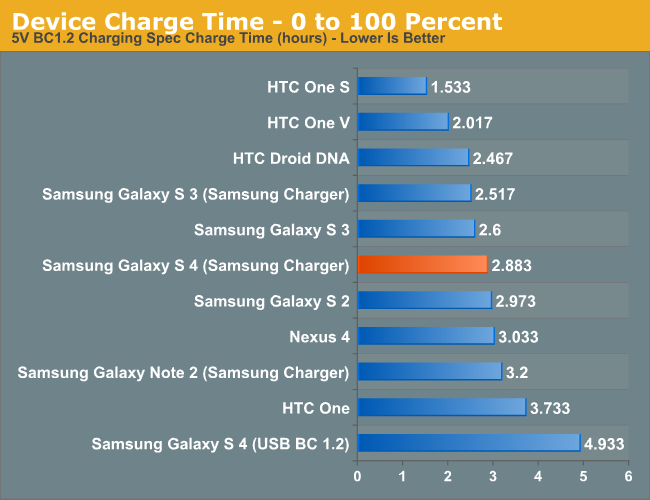


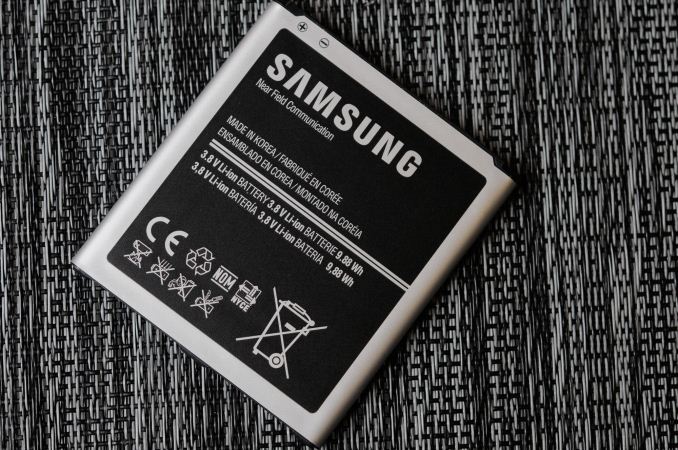








335 Comments
View All Comments
Roy2001 - Friday, April 26, 2013 - link
No plastic and AMOLED which SUCKS.medi02 - Sunday, April 28, 2013 - link
Never heard something as idiotic.Samsung's AMOLED is the reason I don't even consider other manufacturers.
superflex - Friday, May 3, 2013 - link
Until you get it in direct sunlight. AMOLED definitely has it's limitations.Belard - Saturday, April 27, 2013 - link
I find the HTC One a truly exciting design compared to the SGS4... The cheap plastic look and feel of Samsung is why I bought the AtrixHD instead (same feature set, but crappy camera) as it looks different and looks better. The HTC feels like a well made product... looks great all over.But why it MAY NOT matter how the Samsung looks is for people who ALWAYS puts an external protection case over their phones, so with the HTC One & iPhones - you don't get to see sign industrial designs that make them sexy and made the purchase... silly, isn't it?
So... for the case protectors, it doesn't matter.
I like my phone to be as small as possible... I don't use them... and so the HTC One will matter more. Also, all that touchwiz stuff is... kind of ugh.
RiotSloth - Saturday, April 27, 2013 - link
I love Anandtech, and in particular Brian Klug's excellent and objective reviews. If you really want to know all about a new phone, it really is THE place to come and read. I assumed others would feel the same, but NO, there seems to be the same infantile nonsense on here as on other sites. Why do people get so fixated with people's phone choice? As I pointed out on another site, both of these phones are capable of explaining the sum of human knowledge to you almost instantly. they take pictures, they can direct you anywhere, they play music and HD video. In short they are probably the most amazing thing ever created in the whole of human history. And yet people make infantile remarks over whether one is plastic or metal?!MarkHunt - Sunday, April 28, 2013 - link
Have to say it, but majority of the new Chinese Android quad core phones do nearly everything the S4 does for a pittance for a similar performance level. The build quality of the S4 looks no better either.medi02 - Sunday, April 28, 2013 - link
Exactly how much does Samsung save but not using metal cover?Is it really more than couple of bucks?
PS
Got Samsung's first Galaxy S (9001).
About 2 years old.
Never used any kind of protection for it whatsoever. I bet most people whining about it being plastic would use some protective cover on it anyway.
medi02 - Sunday, April 28, 2013 - link
"Most users admittedly don't care however and just see "bright" colors."Uhm, check any pro-sumer camera out there, which of them does NOT oversaturate taken pictures in JPEG mode?
This can't be a hardware fault, can it, after all, RAW looks fine.
So the only reason they oversaturate is because MOST CONSUMERS ACTUALLY LIKE IT THAT WAY. Models that use TFTs can't go as far, since, well, you know, cough, they are actually inferior to AMOLEDs, cough...
rohini - Sunday, April 28, 2013 - link
And finally the Galaxy SIV has been launched in India for INR 41500 which is a bit expensive but it is well under the asking price for the 16GB version of iPhone 5 16GB and HTC Butterfly.People in India who are planning to buy the S IV should also be aware of the other alternatives close to 40k INR. http://goo.gl/MbJ95
Alvar - Monday, April 29, 2013 - link
<a href="http://tinyurl.com/cunrjq6">6 Reasons to get the Samsung Galaxy S4</a>